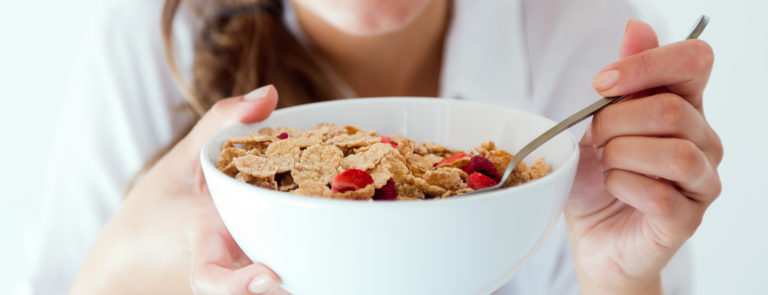20% off €35
6 high fibre breakfast cereals

With fluffy pancakes, muffins and other Instagram-worthy treats taking the spotlight at the breakfast table, it’s easy to forget about the humble bowl of cereal.
However, well-chosen breakfast cereal can be great for your health – giving you the fibre you need to kick-start your day.
The health benefits of fibre
-
Better bowel health
Fibre adds bulk inside your bowel, giving shape and structure to your stool and helping you pass regular bowel movements.
This helps eliminate mucous, dead cells, undigested food and unwanted bacteria from your body.
The benefit of regular bowel movements includes reduced bloating, diarrhoea and constipation.
But did you know regular number twos might also help reduce the risk of disease?
A high-fibre diet has been linked with a reduced risk of bowel cancer particularly – in one study this was particularly true if the fibre is from cereal and wholegrains. 1
-
More stable blood sugar
An analysis of research concluded that eating a diet high in cereal fibre can help lower blood sugar and reduce the risk of developing Type 2 diabetes.2
Soluble fibre slows digestion, and therefore stops carbohydrates being so quickly absorbed into the bloodstream and converted to blood glucose. 3
-
Lower levels of bad cholesterol
Beta-glucans (a type of soluble fibre found in cereal grains such as oats) can help protect you from high levels of bad cholesterol.
These beta-glucans stick to cholesterol during digestion and prevent it from being absorbed into the bloodstream.4
-
A stable weight
Cereals high in fibre can help you manage your weight, too.
Fibre helps you feel full, so a diet rich in fibre means you’re less likely to overeat.
In fact, a high-fibre diet is suggested by US researchers as a way to tackle obesity. 5
Eating fibre also feeds the good bacteria in your gut – vital for creating the optimum environment for digestion. 6
Handpicked content: The best high fibre foods

5 high fibre breakfast recipes
What breakfast cereal has the most fibre?
Check out the top 6 most fibre-rich breakfast cereals.8
-
Wheat bran cereal
A medium sized bowl (40g) of wheat bran cereal contains an impressive 9.8g fibre.9
This type of cereal mainly contains insoluble fibre – an indigestible fibre sometimes called ‘roughage’.
This type of fibre is great for addressing constipation – just don’t eat too much at once as it can cause bloating and gas.
-
Bran flakes
A 40g bowl of bran flakes will provide 7.3g fibre, around a quarter of your daily total.
You can use crushed bran flakes in savoury recipes, too.
Try mixing into a shepherd’s pie or pasta bake, using as a crumb coating for an oven-baked stew.
-
Shredded wheat pillows
Two shredded wheat pillows contain 4.6g fibre.
Adding a handful of almonds (around 23 almonds) that you’ve first crushed in a pestle and mortar will almost double the fibre for this breakfast bowl.
-
Wheat cereal biscuits
2 wheat biscuits contain 3.8g fibre.
Adding a sprinkle of seeds, such as chia, will increase the fibre content of these simple breakfast favourites.
Just 1 tablespoon of chia seeds contains 5g fibre.
-
Muesli
A 45g bowl of muesli contains 3.8g fibre.
You can ramp this up by adding a handful of fresh fruit such as raspberries, which pack 3.5g fibre per 50g.
-
Oats
Porridge oats contain beta-glucan, a form of soluble fibre which is known to help lower cholesterol.
A 40g portion of oats contain around 1.6g beta-glucan, helping you towards the 3g you need daily for cholesterol-lowering effects. 10
Oat have around 3.3g oats per 40g portion, inclusive of beta-glucan.
Mixing in 2 tablespoons of peanut butter takes your bowl to 5.3g fibre – a great start towards your daily 30g target.
Handpicked content: Two ways to make overnight oats
How to spot an unhealthy cereal
It can be difficult to spot the cereals which aren’t that good for us.
Look out for words like ‘frosted’, ‘fruity’, ‘honey’ or ‘choco’ in the product’s title. These all give you a hint that the cereal has lots of added sugar.
Always check the ingredients on the side of the packet. If you see any of the following in the first 3 ingredients, it’s too sugary to eat regularly: 11
- Sugar
- Brown rice syrup
- Corn syrup
- Fructose
- Glucose
- Honey
- Invert syrup
- Maltose
- Dextrose
If you can’t part with your sweet cereal, we suggest sprinkling a handful of your favourite sugary cereal on top of a plainer cereal.
You could also add a few berries to the bowl to add vitamins, minerals and extra bulk to your bowl.
Handpicked content: 8 easy ways to cut down on sugars and sweeteners

Healthy cereal: Does it exist?
What if I don’t like milk?
Perhaps you’re vegan, dairy-free or lactose intolerant. Perhaps you just don’t like the taste of milk.
Either way, there are plenty of options for you to keep cereal on your morning menu.
- Plant milk (soya, oat, almond or coconut) instead of dairy milk
- Plant-based yoghurt with a cereal topping
- Homemade breakfast granola bars. Check our easy recipe
- Oat smoothie, such as this fruity vegan version
Snacking on dry cereal is also great for when you’re feeling nauseous, such as if you’re pregnant or getting over a tummy bug.
If you’re eating cereal dry, then make sure to drink plenty of fluids alongside it to prevent constipation.
Last updated: 25 October 2021
- ttps://www.bmj.com/content/343/bmj.d6617
- https://www.ncbi.nlm.nih.gov/pmc/articles/PMC5883628/
- https://www.diabetes.co.uk/nutrition/soluble-fibre.html
- https://www.lipid.org/sites/default/files/adding_soluble_fiber_final_0.pdf
- https://pubmed.ncbi.nlm.nih.gov/11396693/
- https://www.scientificamerican.com/article/fiber-famished-gut-microbes-linked-to-poor-health1/
- https://www.nhs.uk/live-well/eat-well/how-to-get-more-fibre-into-your-diet/
- https://www.eatthismuch.com/food/nutrition
- https://www.lnds.nhs.uk/Library/DietaryadviceforincreasingfibreOct15.pdf
- https://pubmed.ncbi.nlm.nih.gov/21631511/
- https://www.bhf.org.uk/informationsupport/heart-matters-magazine/nutrition/sugar-salt-and-fat/names-for-sugar-infographic/different-names-for-sugar



